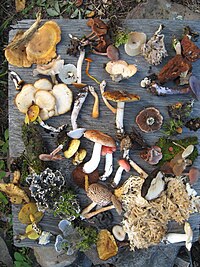
Photo from wikipedia
Anthropogenic conversion of natural to agricultural land reduces aboveground biodiversity. Yet the overall consequences of land-use changes on belowground biodiversity at large scales remain insufficiently explored. Furthermore, the effects of… Click to show full abstract
Anthropogenic conversion of natural to agricultural land reduces aboveground biodiversity. Yet the overall consequences of land-use changes on belowground biodiversity at large scales remain insufficiently explored. Furthermore, the effects of conversion on different organism groups are usually determined at the taxonomic level, while an integrated investigation that includes functional and phylogenetic levels is rare and absent for belowground organisms. Here, we studied the Earth's most abundant metazoa - nematodes - to examine the effects of conversion from natural to agricultural habitats on soil biodiversity across a large spatial scale. To this aim, we investigated the diversity and composition of nematode communities at the taxonomic, functional, and phylogenetic level in 16 assemblage pairs (32 sites in total with 16 in each habitat type) in mainland China. While the overall alpha and beta diversity did not differ between natural and agricultural systems, all three alpha diversity facets decreased with latitude in natural habitats. Both alpha and beta diversity levels were driven by climatic differences in natural habitats, while none of the diversity levels changed in agricultural systems. This indicates that land conversion affects soil biodiversity in a geographically dependent manner and that agriculture could erase climatic constraints on soil biodiversity at such a scale. Additionally, the functional composition of nematode communities was more dissimilar in agricultural than in natural habitats, while the phylogenetic composition was more similar, indicating that changes among different biodiversity facets are asynchronous. Our study deepens the understanding of land-use effects on soil nematode diversity across large spatial scales. Moreover, the detected asynchrony of taxonomic, functional, and phylogenetic diversity highlights the necessity to monitor multiple facets of soil biodiversity in ecological studies such as those investigating environmental changes. This article is protected by copyright. All rights reserved.
Journal Title: Global change biology
Year Published: 2019
Link to full text (if available)
Share on Social Media: Sign Up to like & get
recommendations!